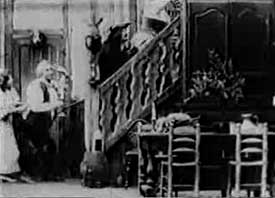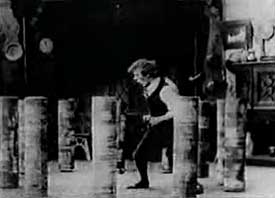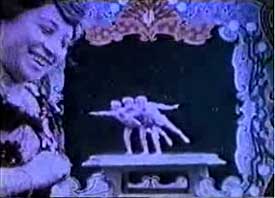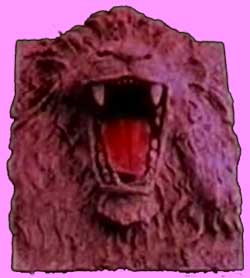 The Spirit Sword (L'Epee du spirite, 1910) by pioneer filmmaker Segundo de Chomon is a fantasy swashbuckler that opens with the arrival at an inn of a musketeer who possesses a magic sword. The tale is told in two distinct chapters: The Spirit Sword (L'Epee du spirite, 1910) by pioneer filmmaker Segundo de Chomon is a fantasy swashbuckler that opens with the arrival at an inn of a musketeer who possesses a magic sword. The tale is told in two distinct chapters:
Part One is subtitled Nicholas & Tonto (Nicolas el Tonto), with the disruption in the inn with a new arrival during a late dinner gathering in the kitchen, location also of sorceress events in Georges Melies' The Cook in Trouble (Sorcellerie culinaire, 1903), Melies being de Chomon's foremost influence.
Two kitchen workers, Nicholas & Tonto, carry on with exaggerated comedy responses when the musketeer turns out also to be a sorcerer.
The table is soon cleared & the magician-musketeer waves what is obviously a magic sword over the table to produce a fancy linen tablecloth. Candelabrum & a basketed floral arrangement float into place.
But table & settings vanish & everyone scuttles about in a dither & seem to be crabbing at the magician-guest for getting their hopes up or for the imperfection of the manifestation.
 The guest is led to his bedroom. He's soon asleep when one of the kitchen clowns sneaks into the room & takes the magic sword, slips back down to the kitchen, drags out a table, & tries the trick for himself. The guest is led to his bedroom. He's soon asleep when one of the kitchen clowns sneaks into the room & takes the magic sword, slips back down to the kitchen, drags out a table, & tries the trick for himself.
Dashing about wildly swinging the sword over & poking it under the table with a look of glee & expectation, absolutely nothing happens.
The sequel follows immediately upon the previous installment. Titled La Valse des Asiattes, the chap who stole the magic sword is leaping on the table & dashing around disappointed that he can cause nothing to materialize.
But then to his surprise kitchen utensels begin flying at him, beating him into submission. Pillars appear all around him, at first solid as tree trunks, then soft like pillows. He rides them, fights them, & is in general bewildered by them.
Meanwhile the owner of the sword awakens from his nap & comes searching for his sword. He & others of the household go in the kitchen where the thief is buried under materialized junk, & very eager to be rid of the sword.
Such trick films were the delight of director Segundo de Chomon, who also made Sculpture Moderne (Sculpteur moderne, 1908), starring Chomon's wife Julienne Mathieu as the lady magician.
 Chomon loved to work with color & designed Sculpture Moderne to be easily hand-tinted. Julienne comes center stage to stand before a large ornate frame. Chomon loved to work with color & designed Sculpture Moderne to be easily hand-tinted. Julienne comes center stage to stand before a large ornate frame.
Revealed inside the frame is a lovely statue of a Greek fighting a Spartan. This is covered with a cloth & vanishes.
The exhibit now becomes quite small. The lady magician whips the cloth from the statue again, revealing other statues of less than a foot height though the originals were life-sized.
She brings in a small set of statues of Greek wrestlers, who come to life just as she's covering them with her cloth & carries them away. Bringing in another covered statue, of the Three Graces, they too are living miniatures. Next she brings in miniatures of wrestlers who move & are actually wrestling.
A framed bas relief depicting warriors is also shown to come alive. The frame is covered & revealed, this time with maenads dancing. Covered again, more warriors are shown in action.
Lastly a lump of clay is brought out & set on the table, where by stop motion animation it turns itself into a hat out of which two clay squirels climb. A second chunk of clay turns itself into a boot out of which climb clay mice. A third chunk molds itself into an eagle. A fourth into a pipe-smoking ape. A fifth into a crocodile. The last into the head of a lion.
A final piece of clay turns into a loaf of bread, slices itself, then turns into a little old lady in a bonnet who walks about. At the end, the lady magician's assistants bring her her cape, & she bows to the audience.
copyright © by Paghat the Ratgirl
|

